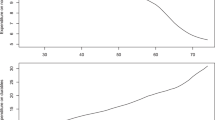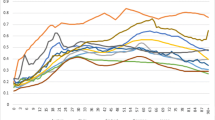Summary
This paper documents life cycle (or age) profiles of (log) household income, durable and non-durable consumption for Dutch households after explicitly controlling for time (or business cycle) effects and birth cohort effects. We find that both measures of consumption as well as income is clearly hump shaped over the life cycle. Hence, real consumption per household seems to track income over the life cycle. This empirical regularity is hard to reconcile with basic specifications of the life cycle model. We further document life cycle profiles of demographic and labor supply variables. We argue that part, but not all, of the hump in consumption may be explained by household composition variables. Durable consumption per adult equivalent stays approximately flat until age 60 after which it drops dramatically. This phenomenon may be partly explained by a decrease in work related durable expenditures after retirement. Non-durable consumption per equivalent adult increases steadily until age 55 and stays approximately flat after that.
Article PDF
Similar content being viewed by others
Avoid common mistakes on your manuscript.
References
Attanasio O.P. (1998) ‘Cohort Analysis of Saving Behavior by U.S. Households’. The Journal of Human Resources 33(3): 575–609
Attanasio O.P., Weber G. (1995) ‘Is Consumption Growth Consistent with Intertemporal Optimization? Evidence from the Consumer Expenditure Survey’. The Journal of Political Economy 103(6): 1121–1157
Auerbach A., Kotlikoff L. (1987) Dynamic Fiscal Policy. Cambridge University Press, Cambridge
Banks J., Blundell R., Tanner S. (1998) ‘Is There a Retirement-Savings Puzzle?’ The American Economic Review 88(4): 769–788
Bernheim B.D., Skinner J., Weinberg S. (2001) ‘What Accounts for the Variation in Retirement Wealth among U.S. Households?’ The American Economic Review 91(4): 832–857
De Ree, J. and R. Alessie (2008), ‘Home Production and the Allocation of Time and Consumption Over the Life Cycle’, Netspar discussion paper DP 07/2008–020, Netspar, Tilburg University.
De Vos K., Zaidi M.A. (1997) ‘Equivalence Scale Sensitivity of Poverty Statistics for the Member States of the European Community’. Review of Income and Wealth 43(3): 319–333
Deaton A., Paxson C. (1994) ‘Intertemporal Choice and Inequality’. The Journal of Political Economy 102(3): 437–467
Draper, D. and A. Amstrong (2007), ‘GAMMA, a Simulation Model for Ageing, Pensions and Public Finances’. CPB document no. 147.
Fernandez-Villaverde J., Krueger D. (2007) ‘Consumption over the Life Cycle: Facts from Consumer Expenditure Survey Data’. Review of Economics and Statistics 89(3): 552–565
Kalmijn, M. and R. Alessie (2008), ‘Life Course Changes in Income: An Exploration of Age and Stage Effects in a 15-year Panel in the Netherlands’. Discussion paper.
Kalwij A., Alessie R., Fontein P. (1998) ‘Household Commodity Demand and Demographics in the Netherlands: A Microeconometric Analysis’. Journal of Population Economics 11(4): 551–577
Kapteyn A., Alessie R., Lusardi A. (2005) ‘Explaining the Wealth Holdings of Different Cohorts: Productivity Growth and Social Security’. European Economic Review 49(5): 1361–1391
Open Access
This article is distributed under the terms of the Creative Commons Attribution Noncommercial License which permits any noncommercial use, distribution, and reproduction in any medium, provided the original author(s) and source are credited.
Author information
Authors and Affiliations
Corresponding author
Rights and permissions
Open Access This is an open access article distributed under the terms of the Creative Commons Attribution Noncommercial License (https://creativecommons.org/licenses/by-nc/2.0), which permits any noncommercial use, distribution, and reproduction in any medium, provided the original author(s) and source are credited.
About this article
Cite this article
Alessie, R., de Ree, J. Explaining The Hump In Life Cycle Consumption profiles. De Economist 157, 107–120 (2009). https://doi.org/10.1007/s10645-009-9119-4
Published:
Issue Date:
DOI: https://doi.org/10.1007/s10645-009-9119-4




